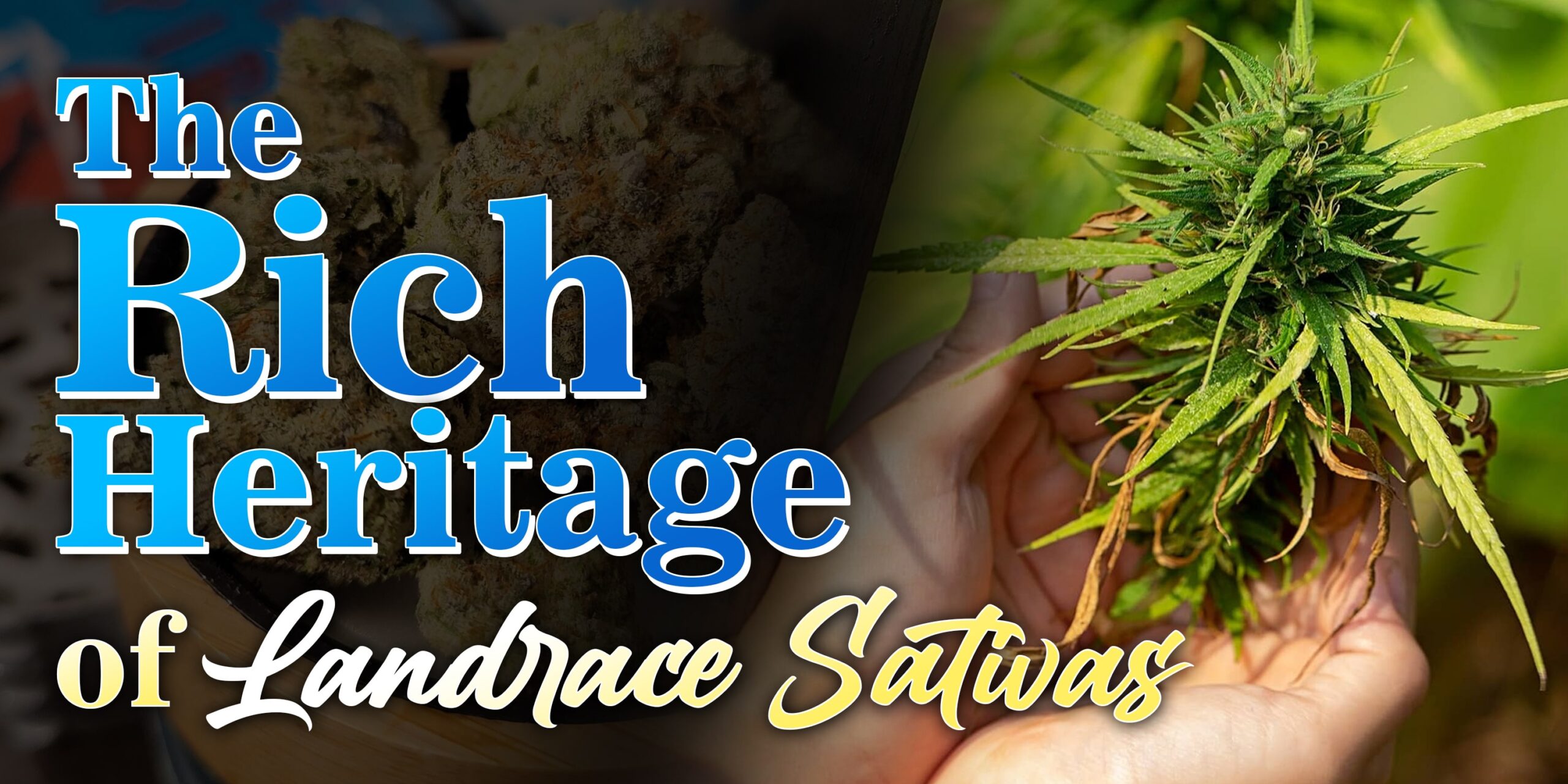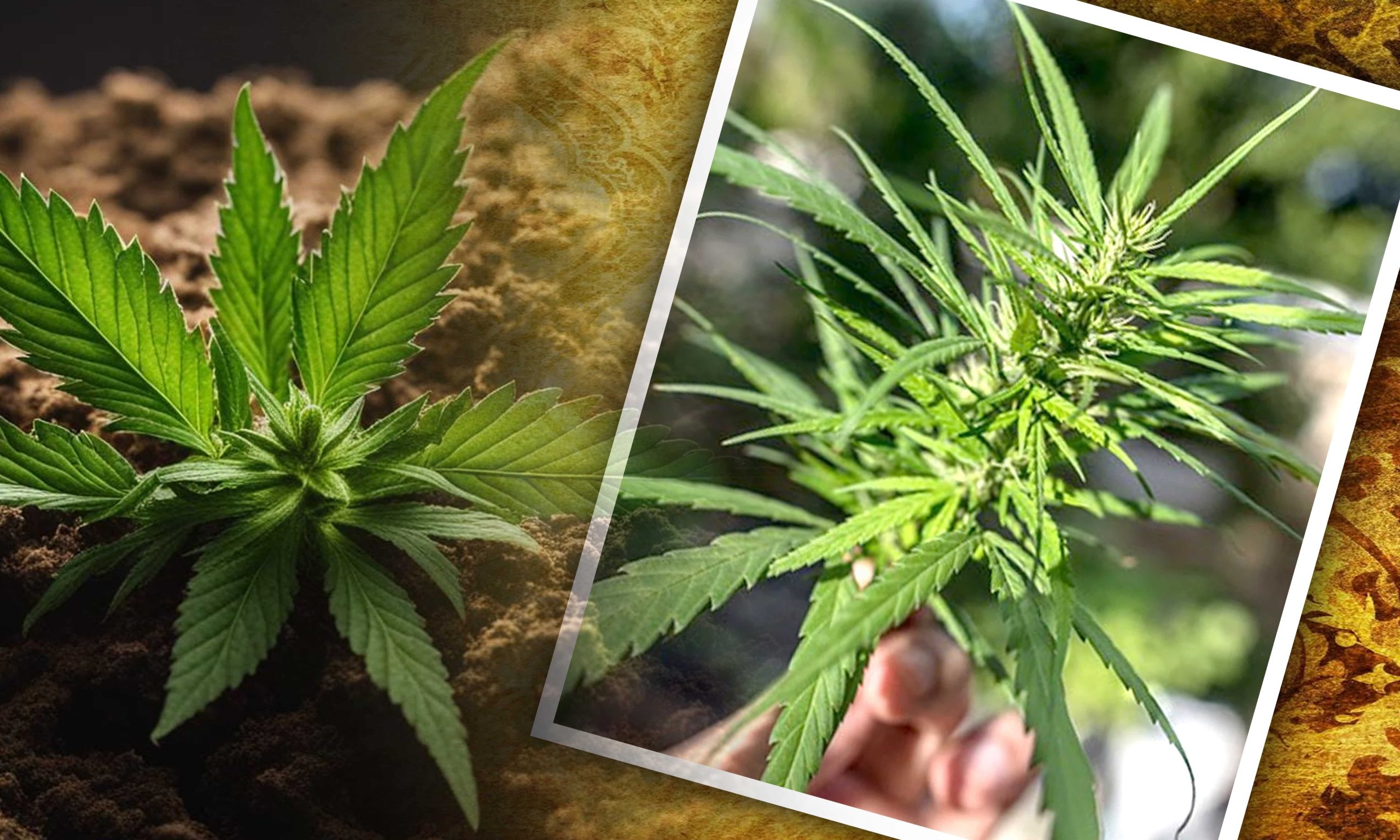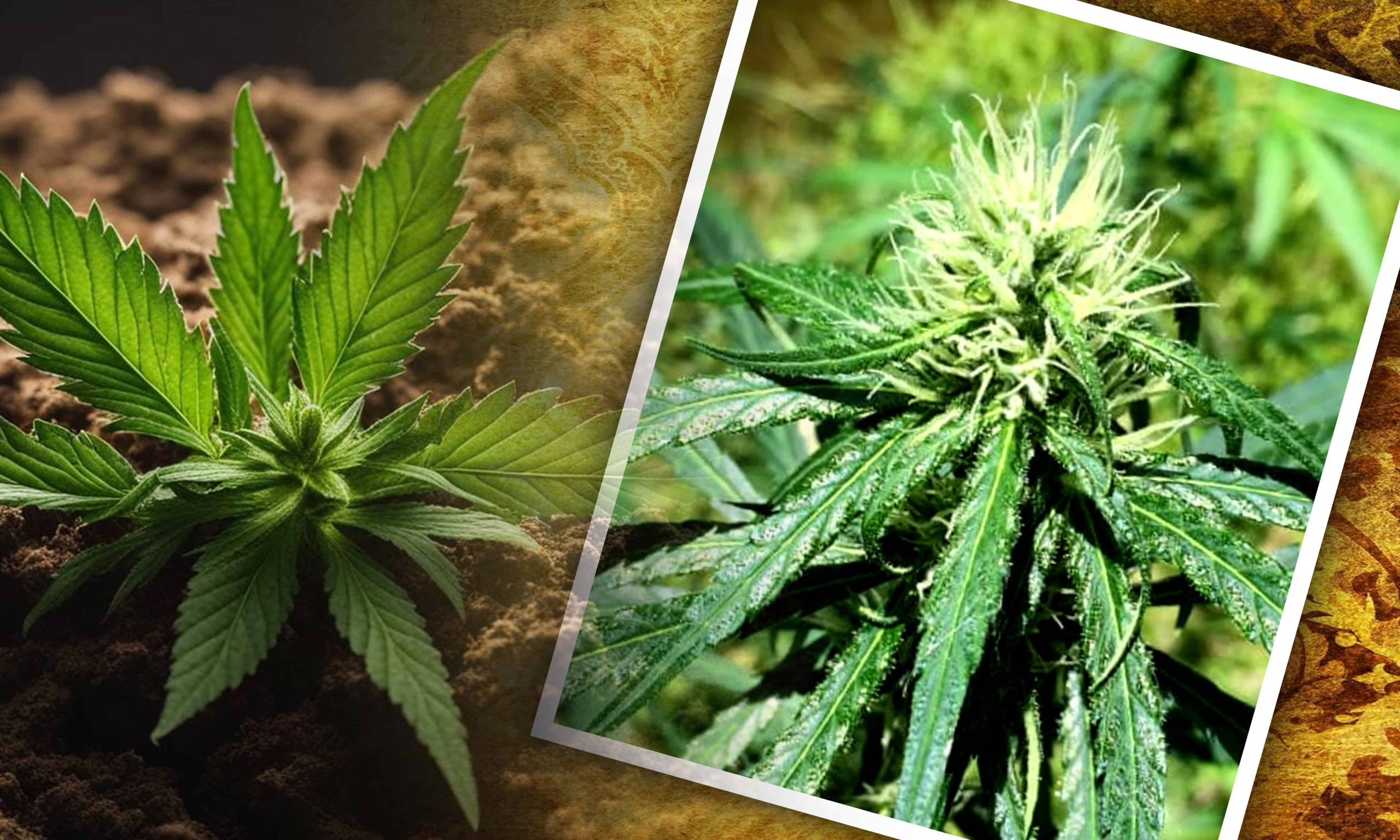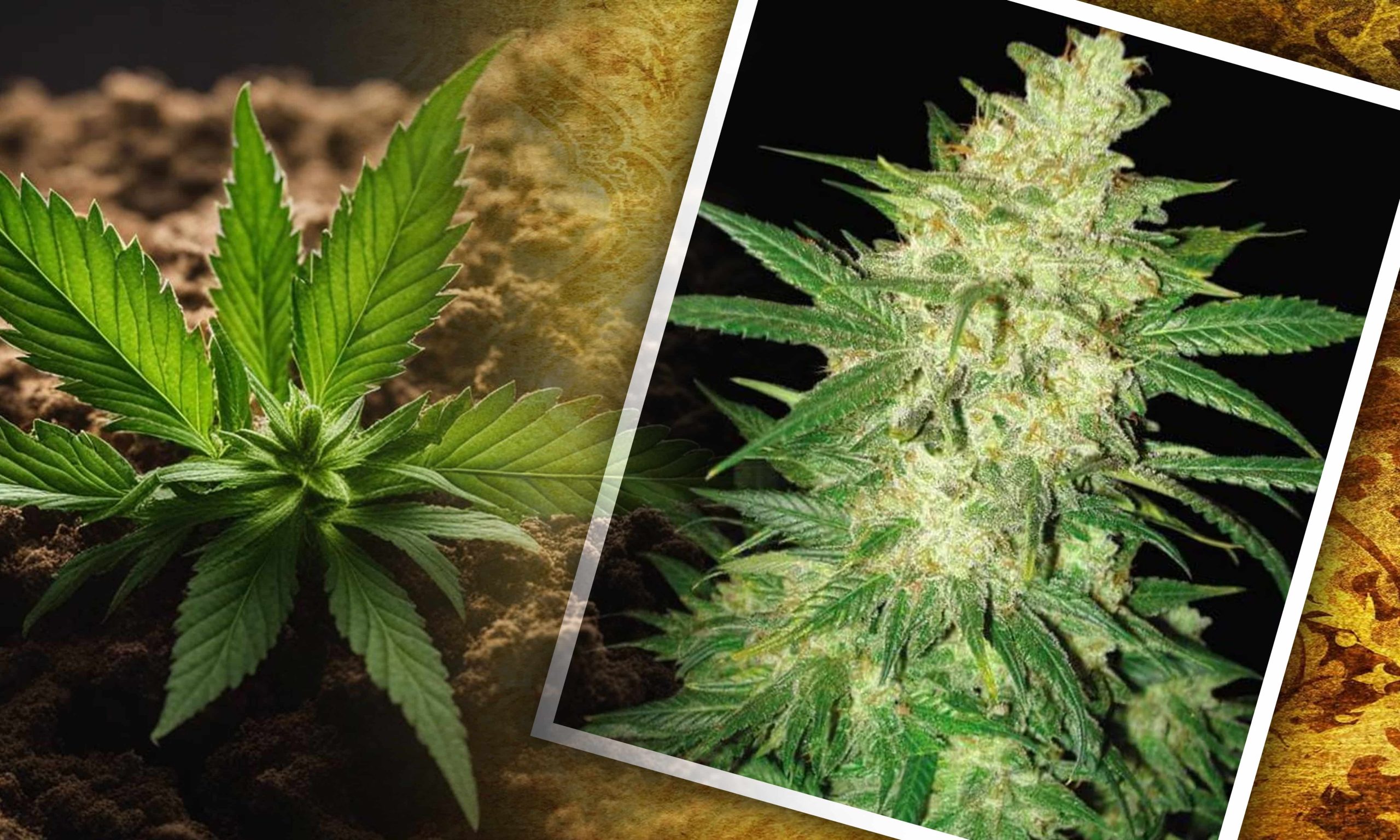Table of Contents

Table of Contents
The roots of Landrace Sativas stretch back millennia to ancient civilizations in Central Asia, the Middle East, and beyond. Early growers carefully bred these plants to thrive in their local climates and customs, leading to the emergence of distinct regional types.
Indigenous to particular areas worldwide, Landrace Sativas showcase the individual environmental settings and cultivation methods of each region. From the Ethiopian highlands to the Jamaican mountains, these strains have thrived in a variety of landscapes and microclimates.
Landrace Sativas usually display tall, slender growth patterns with spacious internodal spacing and sparse leaves. They excel in outdoor growing conditions, where they can achieve remarkable heights and flourish under natural sunlight.
What’s particularly fascinating about Landrace Sativas is their wide range of aromas and flavors, which mirror their geographical roots and terroir. Whether it’s the fruity and floral scents of Thai Sativa or the earthy and spicy hints of Malawi Gold, each strain delivers a distinct sensory journey.
Growing Landrace Sativas successfully necessitates a subtropical to tropical climate with steady warmth, sunlight, and humidity. These plants flourish in areas with lengthy growing seasons and minimal temperature swings, making equatorial regions ideal.
Because of their tall and slender growth tendencies, Landrace Sativas might need extra support and training methods to boost yields and safeguard against wind or rain damage. Techniques like trellising, topping, and low-stress training can help control plant height and encourage uniform canopy growth.

Originating in Thailand, Thai Sativa is celebrated for its invigorating and uplifting effects, earning it a following among daytime consumers. It commonly yields elongated buds that carry a sweet and spicy fragrance, accompanied by a euphoric and cerebral high.

Coming from the African country of Malawi, Malawi Gold is cherished for its strong psychoactive impact and unique citrus taste. It’s famous for bringing on sensations of euphoria, creativity, and mental sharpness, making it a favored option among artists and musicians.

Originating from the mountainous areas of Colombia, Colombian Gold has deep roots in the cultivation practices of indigenous tribes and local farmers for generations. This strain, dominantly sativa, is known for its compact, resinous buds and its earthy, woody scent, offering a balanced and mood-lifting high.
Landrace Sativas present a diverse array of therapeutic advantages, including pain alleviation, mood enhancement, and appetite stimulation. They’re frequently employed to relieve symptoms of medical ailments like chronic pain, depression, anxiety, and nausea, devoid of the sedative traits typically linked with indica strains.
For recreational users, Landrace Sativas offer an uplifted and cerebral sensation that boosts creativity, sociability, and sensory awareness. They’re perfect for daytime pursuits and social occasions, providing an invigorating and stimulating encounter without the heaviness or immobilization often associated with indica strains.
Like all cannabis plants, Landrace Sativas are prone to pests such as spider mites, aphids, and caterpillars, as well as fungal diseases like powdery mildew and botrytis. Integrated pest management (IPM) methods, like using natural predators, organic pesticides, and good cultivation practices, can help prevent and control infestations without resorting to harmful chemicals.
Extreme weather conditions, such as high temperatures, heavy rains, and strong winds, can present challenges for outdoor cultivation of Landrace Sativas. Protective measures like growing in greenhouses, using shade structures, and setting up windbreaks can help reduce the impact of harsh weather and keep growing conditions optimal.
As globalization and industrialization threaten the genetic diversity of cannabis strains, As globalization and industrialization pose risks to the genetic variety of cannabis strains, safeguarding Landrace Sativas becomes more vital for future generations. These original cultivars act as genetic reservoirs for breeding programs, research endeavors, and the preservation of cultural heritage.
Numerous organizations and initiatives are committed to protecting Landrace Sativas and advocating for biodiversity in the cannabis sector. Through seed banks, germplasm collections, and collaborative research projects, these initiatives strive to guarantee the continued existence of these valuable genetic resources and traditional farming methods.
Landrace Sativas offer a window into the cultural heritage and botanical diversity of cannabis strains worldwide. With their unique flavors, effects, and medicinal properties, these ancient cultivars continue to captivate enthusiasts and inspire conservation efforts to preserve their legacy for future generations.
Q: Are Landrace Sativas suitable for indoor cultivation?
A: While Landrace Sativas can be grown indoors with proper lighting and climate control, they tend to thrive best in outdoor environments with abundant sunlight and space.
Q: Do Landrace Sativas have higher THC levels compared to hybrids?
A: THC levels vary among different cannabis strains, including Landrace Sativas and hybrids. Some Landrace Sativas may have high THC content, while others may be lower in potency.
Q: How can I acquire seeds or clones of Landrace Sativa strains?
A: Seeds and clones of Landrace Sativa strains can often be obtained from reputable seed banks, breeders, or cannabis dispensaries specializing in heirloom varieties.
Q: What are the typical flowering times for Landrace Sativas?
A: Landrace Sativas generally have longer flowering periods compared to indica or hybrid strains, often ranging from 10 to 14 weeks or more depending on the specific variety and growing conditions.
Q: Are Landrace Sativas more resistant to pests and diseases?
A: While Landrace Sativas may possess some natural resistance to pests and diseases due to their adaptation to specific environments, they are still susceptible to infestations and infections without proper care and management.

Curious about growing weed in a healthy, effective way? Welcome to the realm of weed hydro! This method uses water instead of soil, delivering n

Peyote Zkittlez is a unique cannabis strain that has quickly gained dedicated followers among enthusiasts and patients alike. Its parentage—Zk

As growers, we want strains that work well, are strong, and are of good quality. Autoflowering cannabis strains are a big step forward for both

Pot growers always ask the same basic question: How much weed does a weed plant produce? The answer is complex and depends on a multitude of var

Ever had the room spin after a few hits? You're not alone. Figuring out how to prevent getting dizzy high can make your cannabis experience a wh

Drying cannabis properly is a critical process in preserving the plant's full aroma and flavor and its psychoactive abilities. Tampering with th

Ever caught yourself a bit too high and all of a sudden in need of being normal? Whether you're heading out for munchies or bumping into someone

Looking for sage advice on how not to get pinched with weed without batting an eye? Attempting to protect your stash from gossipy roommates, sno

Nutrient lockout, also known as nutrient binding or chemical antagonism, is a significant issue in cannabis cultivation that negatively impacts

Germination is the most critical initial stage in growing healthy, high-quality cannabis plants. During germination, the dormant seed becomes a
Are You 18 Or Over?
By selecting “Continue”, you confirm that you are at least 18 years of age and legally permitted to access cannabis related content in your region.
By using Rocketseeds.com, you agree to our legal disclaimer.
Excellent blog here Also your website loads up very fast What web host are you using Can I get your affiliate link to your host I wish my web site loaded up as quickly as yours lol
Your writing is not only informative but also incredibly inspiring. You have a knack for sparking curiosity and encouraging critical thinking. Thank you for being such a positive influence!
Simply wish to say your article is as amazing The clearness in your post is just nice and i could assume youre an expert on this subject Well with your permission let me to grab your feed to keep updated with forthcoming post Thanks a million and please carry on the gratifying work
Somebody essentially lend a hand to make significantly articles Id state That is the very first time I frequented your website page and up to now I surprised with the research you made to make this actual submit amazing Wonderful task
Your blog is a beacon of light in the often murky waters of online content. Your thoughtful analysis and insightful commentary never fail to leave a lasting impression. Keep up the amazing work!
Thank you for the auspicious writeup It in fact was a amusement account it Look advanced to more added agreeable from you By the way how could we communicate
Your blog is a constant source of inspiration for me. Your passion for your subject matter shines through in every post, and it’s clear that you genuinely care about making a positive impact on your readers.
Your blog is a constant source of inspiration for me. Your passion for your subject matter is palpable, and it’s clear that you pour your heart and soul into every post. Keep up the incredible work!
Your articles never fail to captivate me. Each one is a testament to your expertise and dedication to your craft. Thank you for sharing your wisdom with the world.
Your blog is a testament to your dedication to your craft. Your commitment to excellence is evident in every aspect of your writing. Thank you for being such a positive influence in the online community.
Your writing has a way of resonating with me on a deep level. I appreciate the honesty and authenticity you bring to every post. Thank you for sharing your journey with us.
Your blog is a true gem in the world of online content. I’m continually impressed by the depth of your research and the clarity of your writing. Thank you for sharing your wisdom with us.
Hi i think that i saw you visited my web site thus i came to Return the favore Im attempting to find things to enhance my siteI suppose its ok to use a few of your ideas
Somebody essentially help to make significantly articles Id state This is the first time I frequented your web page and up to now I surprised with the research you made to make this actual post incredible Fantastic job
Usually I do not read article on blogs however I would like to say that this writeup very compelled me to take a look at and do so Your writing taste has been amazed me Thanks quite nice post
Your blog has quickly become one of my favorites. Your writing is both insightful and thought-provoking, and I always come away from your posts feeling inspired. Keep up the phenomenal work!
Every time I visit your website, I’m greeted with thought-provoking content and impeccable writing. You truly have a gift for articulating complex ideas in a clear and engaging manner.
Hey there You have done a fantastic job I will certainly digg it and personally recommend to my friends Im confident theyll be benefited from this site
I have read some excellent stuff here Definitely value bookmarking for revisiting I wonder how much effort you put to make the sort of excellent informative website
Nice blog here Also your site loads up very fast What host are you using Can I get your affiliate link to your host I wish my site loaded up as quickly as yours lol
What i do not understood is in truth how you are not actually a lot more smartlyliked than you may be now You are very intelligent You realize therefore significantly in the case of this topic produced me individually imagine it from numerous numerous angles Its like men and women dont seem to be fascinated until it is one thing to do with Woman gaga Your own stuffs nice All the time care for it up
Your blog is a beacon of light in the often murky waters of online content. Your thoughtful analysis and insightful commentary never fail to leave a lasting impression. Keep up the amazing work!
Your blog is a breath of fresh air in the often stagnant world of online content. Your thoughtful analysis and insightful commentary never fail to leave a lasting impression. Thank you for sharing your wisdom with us.
Your blog is a beacon of light in the often murky waters of online content. Your thoughtful analysis and insightful commentary never fail to leave a lasting impression. Keep up the amazing work!
Usually I do not read article on blogs however I would like to say that this writeup very compelled me to take a look at and do it Your writing style has been amazed me Thank you very nice article
Your writing has a way of resonating with me on a deep level. I appreciate the honesty and authenticity you bring to every post. Thank you for sharing your journey with us.
This hydroponics guide is quite the buzz, seriously! Who knew growing weed without dirt could be so complicated yet potentially rewarding? The breakdown of systems like DWC and NFT is helpful, though I suspect my cat might confuse the air pump for a toy. The idea of cleaner buds is tempting, especially since explaining hydro weed to my non-growing friends might get messy. And the bit about potential dizziness from hydro weed? Perfect, now I have an excuse for why I always stumble a bit after a grow session. Still, the promise of faster grows and higher yields is hard to ignore, even if it means more trips to the pH meter than to the coffee shop. Overall, a cultivating read for the curious grower!